Adenium: description, types and care at home
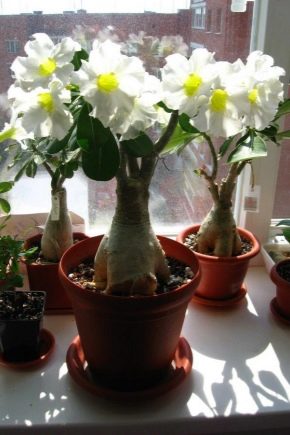
Adenium is a succulent plant with many popular names. These are "Impala Lily", and "Desert Rose" and "Sabinia Star". Until recently, almost no one heard about this beautiful plant. However, now this flower is gradually gaining popularity. After all, it is easy to care for it, and adenium grown at home looks attractive throughout the year.
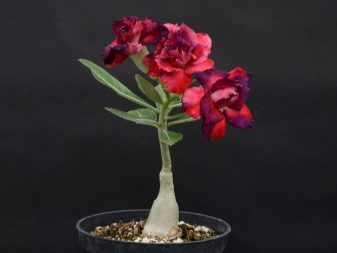
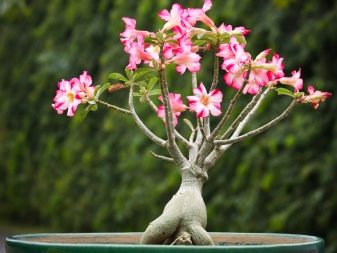
Peculiarities
If we talk about adenium, then it is the most beautiful desert flower, because it is not for nothing that it was called the “desert rose”. It belongs to the woody cacti of the Kutrovy family. Africa is considered the birthplace of adenium, as well as the island of Socotra. In addition, the plant can be found on the Arabian Peninsula.
Now in nature, there are more than 50 species of this plant, which can grow even up to 10 meters. However, this is only possible in natural habitat. At home, you can only grow obese adenium.
At first glance, it seems to many that this plant was created by human hands, but this is not so.
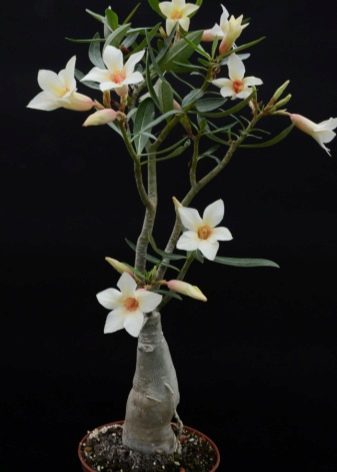
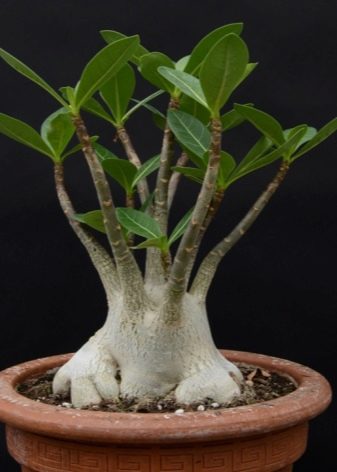
Indoor succulent is slightly smaller in comparison with its relatives, its height reaches 35 centimeters. This is a beautiful compact tree or shrub, with a slight thickening at the very base. The curly stem is densely covered with flowers, a bit like a funnel. They reach 7 centimeters in diameter. Their color is different: from white to red. You can also find multicolored plants, in which the petals can be both ordinary and double. Most often they bloom in spring or summer, however, this can also occur in early autumn. It all depends on the type of succulent. Flowering begins at the age of two.
In addition, the plant has elongated leaves on small petioles. Most often they are green in color, but sometimes they are yellow or white. In addition, their surface can be either glossy or matte. Do not forget about the roots of this plant. They are often also called caudex. They are slightly modified. Thanks to this, the succulent makes itself water reserves during the drought. Since the plant grows larger every year, its root system also increases. Roots grow underground, however, over time, some gardeners lift them up to admire the beauty of their curves.

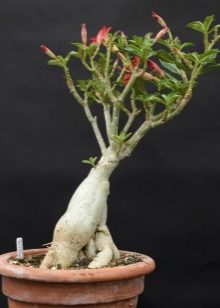
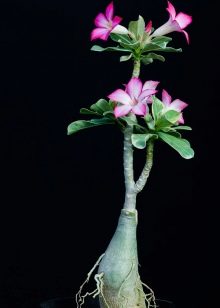
Views
There are several varieties of adenium, of which only 12 have been registered so far. Some of them are very popular. To replenish your knowledge, you need to consider all these varieties in more detail.
- Mini. This small subspecies of adenium differs in that it grows rather slowly. In addition, flowers on the same bush can have completely different shades. All this happens due to the fact that different varieties of this plant are grafted onto one trunk.
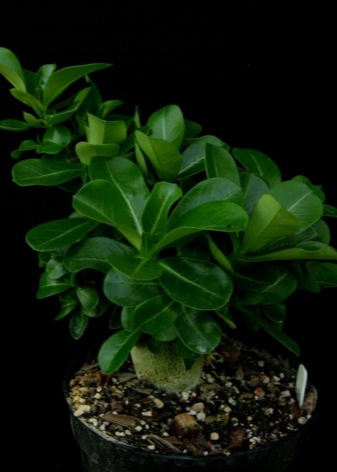
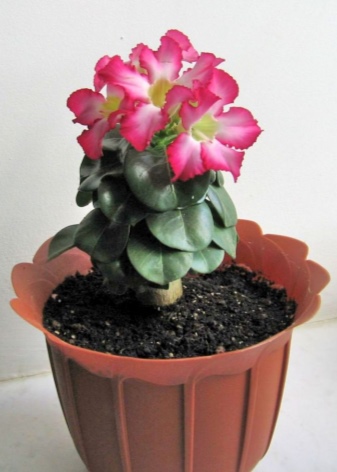
- Arabicum. This succulent has a fairly wide caudex, which varies in color from light to black. Succulent leaves are up to 20 centimeters long and up to 10 centimeters wide. In addition, they are somewhat velvety. The flowers of the plant are very beautiful, green with a pink tint.
This adenium begins to bloom in early spring and continues until autumn.


- Somali. Its full name sounds like "Adenium Somalense".Such a succulent is a tree that can grow up to 4-5 meters. Moreover, its leaves are rather narrow and long. This species is considered the largest among other relatives. Flowering begins from the first year. At this time, its height is no more than 20 centimeters. If all the rules for care are followed, then flowers of a burgundy or pink hue can appear on it for a whole year. Their shape is a bit like stars.
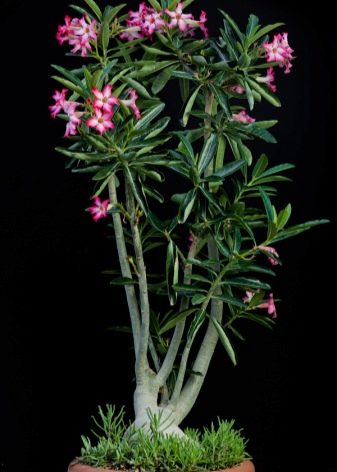
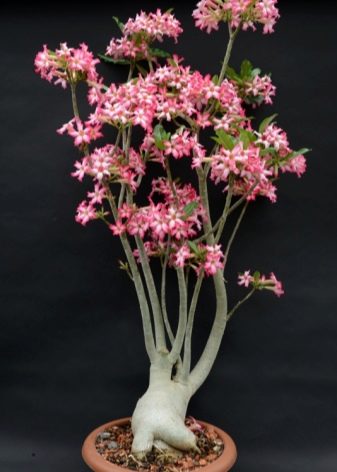
- Multiflorum. Its name is translated as a multi-flowered plant. It grows fast enough and under more favorable conditions it can reach 3 meters. Its root system is large, however, over time it becomes smaller, and then completely disappears. Flowering occurs in winter. It was at this time that beautiful white flowers with a maroon border appear on it. This subspecies is most often used for crossing in order to obtain different hybrids.
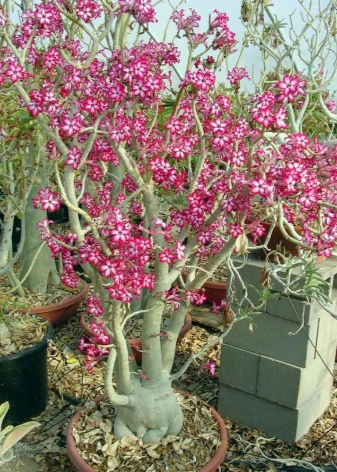
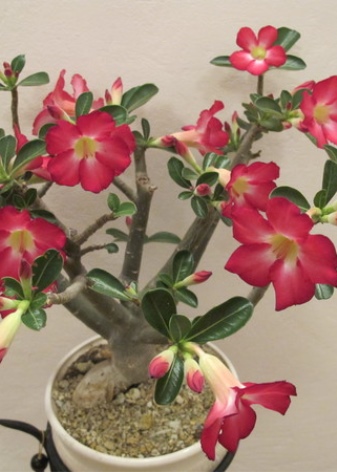
- Socotransky. The roots of this succulent can grow up to 2 meters. And the branches are at the very top. It grows more slowly than other relatives. Its pink flowers are up to 15 centimeters in diameter, and the leaves grow up to 11 centimeters long.
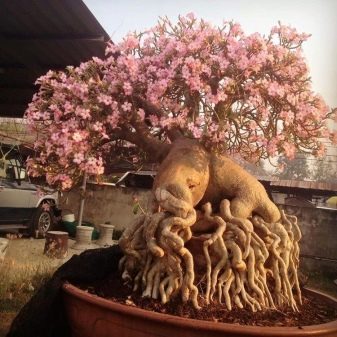
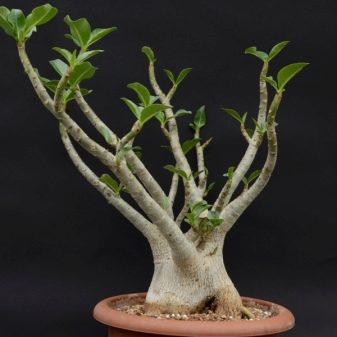
- Obesum. The name is translated as obese or even fat. It is the most common succulent with thickened stems that taper upwards. Its flowers are up to 8 centimeters in diameter and appear in early spring. At the same time, they are both double, a little reminiscent of roses, and simple, consisting of 5 petals.

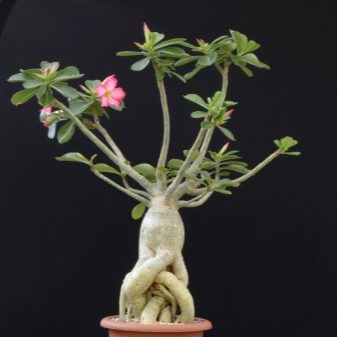
- Boehmianum. This species is considered poisonous. The flowers of this plant are arranged as if in a spiral. Flowering can last more than 3 months.
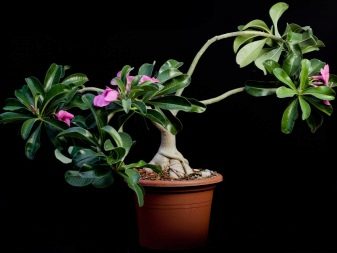
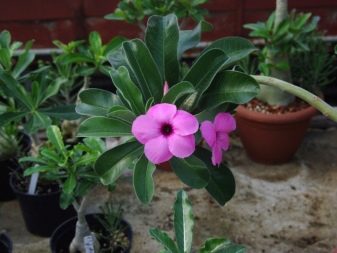
Conditions of detention
Such succulents will feel great both at home and in huge offices. But for this they need to create certain conditions, which consist in observing the temperature regime, the correct selection of the substrate and other conditions.
Lighting
Since hot countries are the homeland of this plant, the sun's rays are not at all scary for it. In the summertime, it can be planted directly outside, however, for a start, the succulent needs to be hardened a little. Indeed, in winter, the lighting is not so bright, and therefore in the spring after "hibernation" the leaves may even get burned.
In the house, it can be placed on the south side, however, from time to time it is necessary to turn in different directions so that the plant receives uniform illumination.
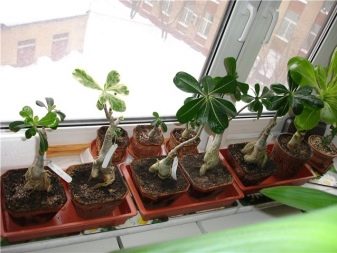

Temperature and humidity
The temperature regime can be completely different. For example, in the summer, the plant can withstand heat up to 36 degrees. In this case, humidity does not matter, since adenium calmly survives in the desert. However, spraying is still possible, but only to remove dust. This must be done very carefully so as not to spoil the appearance of the flowers.
But in the fall, when daylight hours are significantly reduced, spraying must be stopped altogether.... Otherwise, various fungal diseases can affect the succulent.
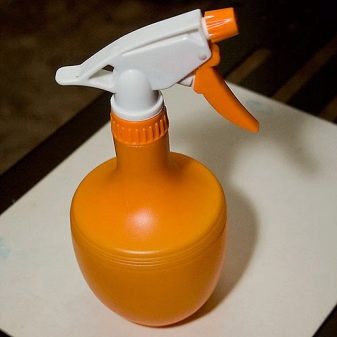
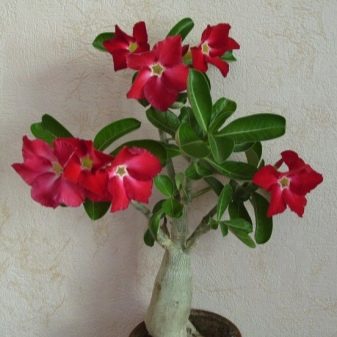
Priming
It is best to buy the substrate from specialized stores. It must be both moisture permeable and breathable. At the same time, there should be as little sand in it, it is better if it is larger, since small grains of sand will only slow down the growth of the succulent. If this is not possible, then it can be prepared at home. The composition of the substrate is completely different.
First option:
- one part of deciduous humus;
- 1 part of very fine expanded clay;
- some brick chips.
Second option:
- 5 pieces of substrate from a specialist store;
- 3 parts deciduous humus;
- 2 parts of either vermiculite or perlite;
- 1 part charcoal, preferably charcoal.
You can also add some pine bark or small pieces of styrofoam. However, it must be remembered that in this case the plant will need more nutrients.
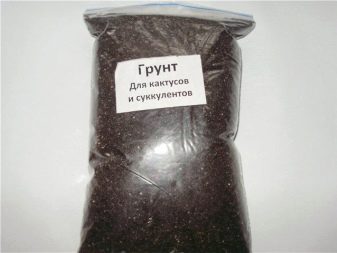

Transfer
For adenium, timely transplantation is very important, which must be done annually with the onset of spring. But this is only relevant for a young succulent. But for an adult plant, a transplant is necessary only once every 3 years. To do this, you need to choose a fairly low capacity, moreover, it should be wider. It is best if the pot is made of plastic, because it does not heat up as much under the sun as ceramic flowerpots.
The plant must be carefully removed and lightly shaken off the ground. After that, you can start planting it in a new substrate. Watering the plant after transplanting is necessary only when the soil is completely dry.
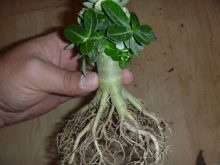
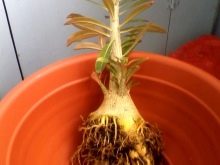

How to care?
Growing adenium at home is not so difficult. The main thing is to provide him with proper care, which will be effective even for novice gardeners. After all, this is a completely unpretentious plant that does not require special skills.
The only thing to do is to remember some rules that need to be followed in order to grow a healthy and strong succulent.


Fertilizer
This process is very important for this plant, especially when growing at home. So, during the growing season, fertilization must be applied almost every month. To do this, you can use special preparations that can be purchased at garden stores. However, they must be diluted with water in accordance with the instructions.
The fertilizers used can be for cacti and common houseplants. However, in the second case, the concentration should be minimal so as not to overdo it with minerals. If nitrogen is needed at the very beginning of development, then after that it can be replaced with compounds that will include potassium and phosphorus. But in the winter, it is better to stop adding any fertilizers.
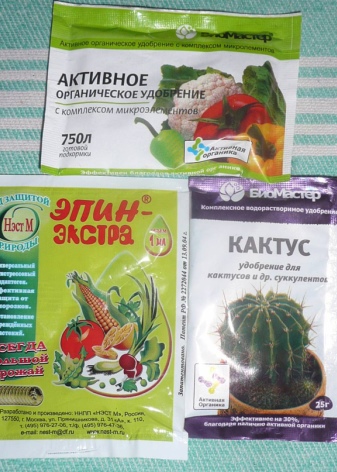
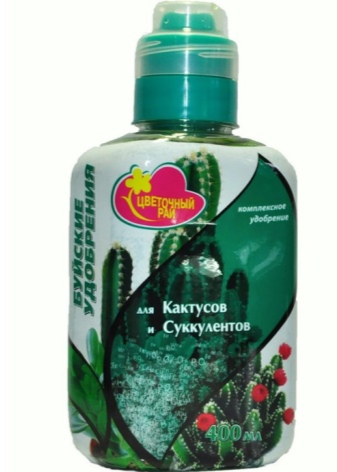
Watering
If under natural conditions this flower is accustomed to drought and has learned to accumulate all moisture in the roots, then at home it should also be given the opportunity to exist in the same conditions. You should not flood the plant with water and it is very important to ensure that the substrate has time to dry out between waterings. If it is still wet, then you should skip this procedure so as not to rot the roots.
But on winter days, when the plant is "asleep", the frequency of watering must be slightly reduced, and in the period of severe cold, and completely stopped. When his "awakening" begins, the amount of water can be gradually increased. And only 2 weeks after the first buds appear on the succulent, it can be fully and regularly watered.
Additionally, spraying is not worth it, as this will adversely affect the condition of the plant.

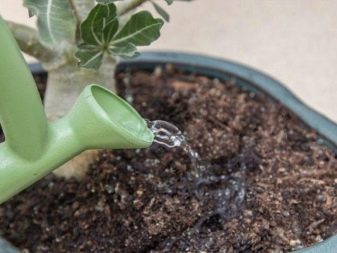
Bloom
Of course, the period when adenium begins to bloom will not leave anyone indifferent. After all, such beauty can delight those around the whole summer and even a little in the fall. A single flower can bloom for a whole week, after which a new one blooms in its place. To force the succulent plant to increase its flowering frequency, it is neatly pruned, resulting in a carpet of flowers covering the entire bush.
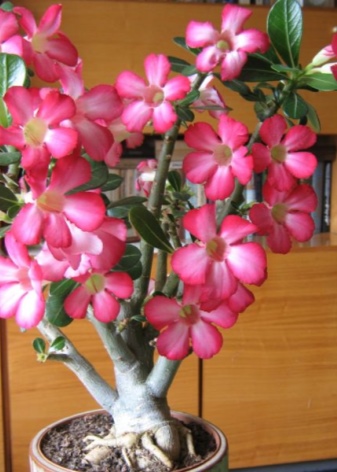

Pruning
If the topic of pruning has already been touched upon, then it must be said that it is being done not only to increase the number of flowers on this mini-tree. This process is possible in the following cases.
- It happens that the handsome adenium stops blooming. In this case, you can carry out such a procedure.
- Most often this is necessary to create a beautiful, luxurious crown.
- Root pruning is also possible to make the transplanting process a little easier.
- Any parts of the flower that show signs of disease are also cut off.
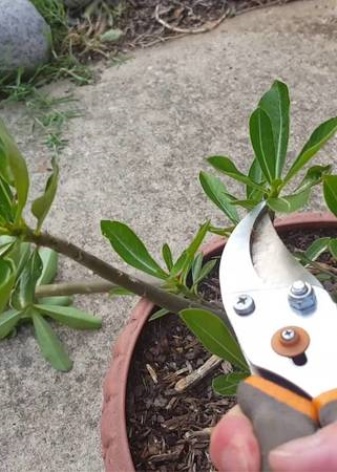
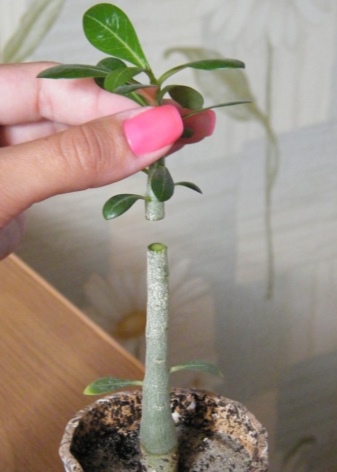
For any of the above cuts, you must follow some rules. For example, before starting the process, the plant is washed with warm water.
Slices need to be done not closer than 1 centimeter from the caudex. In addition, the temperature should not exceed 25 degrees above zero. Pruning is best done in early spring.All cut sites must be treated with a disinfectant. Do not be afraid that juice will flow from the wound for several days. All this is natural. If after this procedure there are too many thin branches, then most of them must be carefully plucked out.
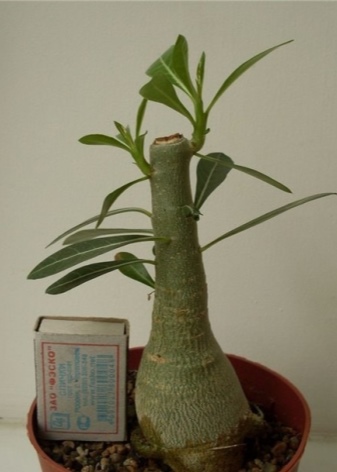
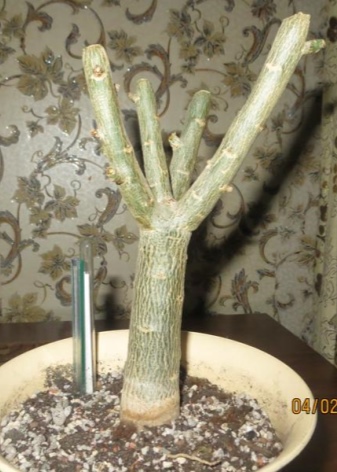
Reproduction
For reproduction of adenium, you can use several methods at once. Often this is done with apical cuttings, grafting on oleander or second adenium, as well as seeds. All processes are best done in the spring, when the plant is just waking up.
Cuttings
This is a rather painstaking task. First you need to cut off the cuttings, the length of which should be at least 10 centimeters. After that, they should dry out for several days, and then they should be placed in well-moistened soil, which should include as much sand as possible. For rooting, a container with seedlings must be placed in a warm and well-lit place. The temperature should be up to 24 degrees. If all the rules are followed, roots will appear in a month and only then can the soil be watered.
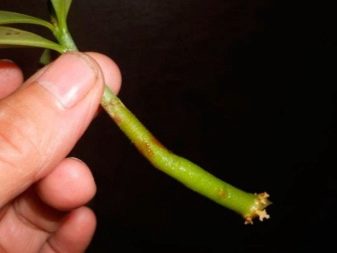
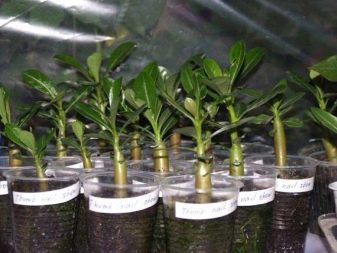
Seeds
It is very difficult to get the seed of this plant, but it is thanks to this method that interesting specimens of adenium can be obtained. To begin with, the seeds must be soaked in warm water, and then you can sow them in a previously prepared container with a special moistened soil. The sowing depth should be no more than 6 millimeters. The container must be placed in a warm place where the temperature will be within 35 degrees. When 4 leaves already appear, you can dive the seedlings into separate containers. It will be easy enough to root them after that.
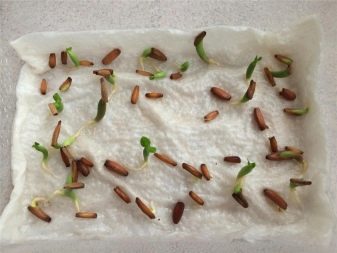

Vaccination
It is best to propagate such a plant by grafting on adenium seedlings. This option allows the succulent to look more natural in the future, since the place where the vaccine was made will not be visible over time.
However, an adult plant can also be used. Then several different varieties of adenium are grafted onto it at once.
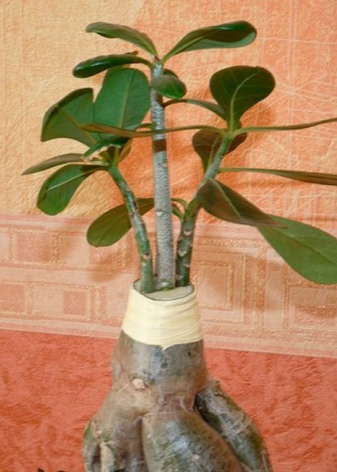
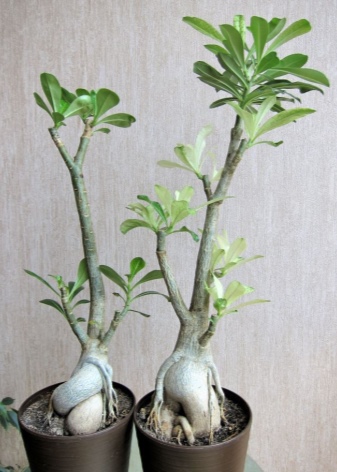
Diseases and pests
Very often you can see that the tips dry on the mini-tree, the leaves turn yellow, and sometimes they completely fall off. All this can happen due to the appearance of certain diseases. Most often this is excess moisture. In this case, fungal lesions appear. Then the root system of the plant suffers, which is very susceptible to this. To prevent this from happening, it is necessary to make the drainage layer thicker. In some cases, some of the affected roots are simply cut off and disinfected.
However, this can also occur due to the appearance of viral infections. This will not kill the plant, however, it will begin to "die" very slowly. At first, the flower just looks worse, and then sheds all the leaves. It is almost impossible to deal with such problems, so the only thing that needs to be done is to destroy the infected plants, preferably together with a flowerpot.
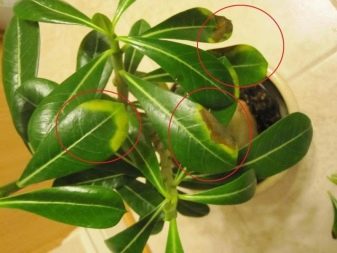
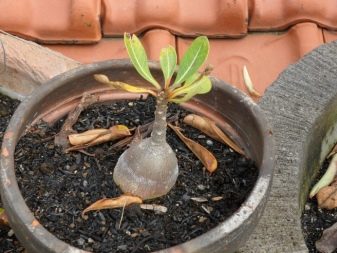
If we talk about pests, then most often they can be root worms or spider mites. When the first appear, the entire root system is covered with a bloom of white. For treatment, you can try to treat the soil with an insecticide. With the appearance of a tick, young shoots, as well as the flowers of the plant, are most often affected. Everything is covered with a thin web, and the leaves begin to disappear. To get rid of uninvited guests, you need to treat the entire plant with chemicals that can be purchased in specialized stores.
Summing up, we can say that such a plant should be purchased in your mini-garden. It won't take much time to care for it. But such a succulent will decorate any home.
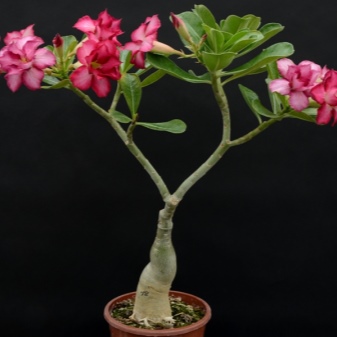
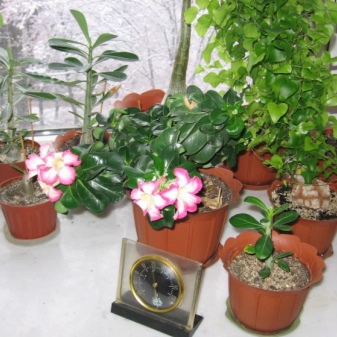
For more information on adenium, see the next video.


















































Ksenia, you are super pro! Everything is clear, concise and understandable. Thanks to. I will grow this miracle!
The comment was sent successfully.